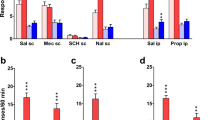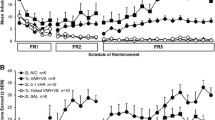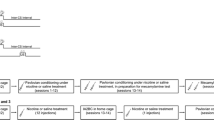Abstract
Rationale
The mesolimbic dopamine system has been implicated in the primary reinforcing properties of drugs of abuse as well as in enhanced responding with conditioned reinforcement produced by psychomotor stimulant drugs. Despite clinical observations that nicotine self-administration (i.e. smoking) depends strongly upon conditioned reinforcement (i.e. cues support smoking behavior), little is known about whether nicotine directly affects motivational processes.
Objective
In these experiments, we investigated whether acute nicotine would influence responding with conditioned reinforcement and the degree to which pretreatment with the nicotinic acetylcholine receptor (nAChR) antagonist mecamylamine would modify any nicotine-induced behavioral effects.
Methods
After subjects had been trained to associate an initially neutral stimulus with water reward, they received acute nicotine (43,25–350 µg/kg SC; −5 min) or saline injections and were tested on the acquisition of a new response for conditioned reinforcement paradigm. In separate experiments, the effect of pretreatment with the nicotinic acetylcholine receptor antagonist mecamylamine (300 or 1000 µg/kg SC; −20 min) alone, or in combination with nicotine (350 µg/kg SC; −5 min), on conditioned reinforcement was also examined.
Results
Acute nicotine injection produced a selective enhancement of responding with conditioned reinforcement (i.e. on the CR lever), without producing non-selective increases in overall responding. The effect of nicotine (350 µg/kg SC; −5 min) was selectively blocked by mecamylamine (300 µg/kg).
Conclusions
These findings demonstrate that acute exposure to nicotine augments the control over behavior by a conditioned reinforcer, suggesting that nicotine may enhance motivational processes.


Similar content being viewed by others
References
Balfour DJ, Wright AE, Benwell ME, Birrell CE (2000) The putative role of extra-synaptic mesolimbic dopamine in the neurobiology of nicotine dependence. Behav Brain Res 113:73–83
Berke JD, Hyman SE (2000) Addiction, dopamine, and the molecular mechanisms of memory. Neuron 25:515–532
Burns LH, Everitt BJ, Kelley AE, Robbins TW (1994) Glutamate-dopamine interactions in the ventral striatum: role in locomotor activity and responding with conditioned reinforcement. Psychopharmacology 115:516–528
Cador M, Taylor JR, Robbins TW (1991) Potentiation of the effects of reward-related stimuli by dopaminergic-dependent mechanisms in the nucleus accumbens. Psychopharmacology 104:377–385
Caggiula AR, Donny EC, White AR, Chaudhri N, Booth S, Gharib MA, Hoffman A, Perkins KA, Sved AF (2001) Cue dependency of nicotine self-administration and smoking. Pharmacol Biochem Behav 70:515–530
Carter BL, Tiffany ST (1999) Meta-analysis of cue-reactivity in addiction research. Addiction 94:327–340
Childress AR, Mozley PD, McElgin W, Fitzgerald J, Reivich M, O'Brien CP (1999) Limbic activation during cue-induced cocaine craving. Am J Psychiatry 156:11–18
Corrigall WA, Coen KM, Adamson KL (1994) Self-administered nicotine activates the mesolimbic dopamine system through the ventral tegmental area. Brain Res 653:278–284
Cunningham ST, Kelley AE (1992) Opiate infusion into nucleus accumbens: contrasting effects on motor activity and responding for conditioned reward. Brain Res 588:104–114
Di Chiara G, Imperato A (1988) Drugs abused by humans preferentially increase synaptic dopamine concentrations in the mesolimbic system of freely moving rats. Proc Natl Acad Sci USA 85:5274–5278
Dols M, Willems B, van den Hout M, Bittoun R (2000) Smokers can learn to influence their urge to smoke. Addict Behav 25:103–108
Due DL, Huettel SA, Hall WG, Rubin DC (2002) Activation in mesolimbic and visuospatial neural circuits elicited by smoking cues: evidence from functional magnetic resonance imaging. Am J Psychiatry 159:954–960
Everitt BJ, Robbins TW (1992) Amygdala-ventral striatal interactions in reward-related processes. In: Aggelton JP (ed) The amygdala. Wiley, New York, pp 401–409
Everitt BJ, Wolf ME (2002) Psychomotor stimulant addiction: a neural systems perspective. J Neurosci 22:3312–3320
Everitt BJ, Dickinson A, Robbins TW (2001) The neuropsychological basis of addictive behaviour. Brain Res Brain Res Rev 36:129–138
Grant S, London ED, Newlin DB, Villemagne VL, Liu X, Contoreggi C et al. (1996) Activation of memory circuits during cue-elicited cocaine craving. Proc Natl Acad Sci USA 93:12040–12045
Grenhoff J, Svensson TH (1988) Selective stimulation of limbic dopamine activity by nicotine. Acta Physiol Scand 133:595–596
Hill RT (1970) Facilitation of conditioned reinforcement as a mechanism of psychomotor stimulation. In: Costa E, Garattini S (eds) International symposium on amphetamines and related compounds. Raven Press, New York, pp 781–795
Hyman SE, Malenka RC (2001) Addiction and the brain: the neurobiology of compulsion and its persistence. Nat Rev Neurosci 2:695–703
Jentsch JD, Taylor JR (1999) Impulsivity resulting from frontostriatal dysfunction in drug abuse: implications for the control of behavior by reward-related stimuli. Psychopharmacology 146:373–390
Kelley AE, Berridge KC (2002) The neuroscience of natural rewards: relevance to addictive drugs. J Neurosci 22:3306–3311
Kelley AE, Delfs JM (1991a) Dopamine and conditioned reinforcement. I. Differential effects of amphetamine microinjections into striatal subregions. Psychopharmacology 103:187–96
Kelley AE, Delfs JM (1991b) Dopamine and conditioned reinforcement. II. Contrasting effects of amphetamine microinjection into the nucleus accumbens with peptide microinjection into the ventral tegmental area. Psychopharmacology 103:197–203
Koob GF (1992) Drugs of abuse: anatomy, pharmacology and function of reward pathways. Trends Pharmacol Sci 13:177–84
Le Moal M, Simon H (1991) Mesocorticolimbic dopaminergic network: functional and regulatory roles. Physiol Rev 71:155–234
Mackintosh NJ (1974) The psychology of animal learning. Academic Press, New York
Markou A, Weiss F, Gold LH, Caine SB, Schulteis G, Koob GF (1993) Animal models of drug craving. Psychopharmacology 112:163–182
Mogenson GJ, Jones DL, Yim CY (1980) From motivation to action: functional interface between the limbic system and the motor system. Prog Neurobiol 14:69–97
Mogenson GJ, Brudzynski S, Wu M, Yang C, Yim C (1993) From motivation to action: a review of dopaminergic regulation of limbic-nucleus accumbens-ventral pallidum-pedunculopontine nucleus circuitries involved in limbic-motor integration. In: Kalivas PW, Barnes CD (eds) Limbic motor circuits and neuropsychiatry. CRC Press, Boca Raton, pp 193–236
Mucha RF, Pauli P, Angrilli A (1998) Conditioned responses elicited by experimentally produced cues for smoking. Can J Physiol Pharmacol 76:259–268
Mucha RF, Geier A, Pauli P (1999) Modulation of craving by cues having differential overlap with pharmacological effect: evidence for cue approach in smokers and social drinkers. Psychopharmacology 147:306–313
Niaura R, Abrams D, Demuth B, Pinto R, Monti P (1989) Responses to smoking-related stimuli and early relapse to smoking. Addict Behav 14:419–428
Nisell M, Marcus M, Nomikos GG, Svensson TH (1997) Differential effects of acute and chronic nicotine on dopamine output in the core and shell of the rat nucleus accumbens. J Neural Transm 104:1–10
O'Brien CP, Childress AR, Ehrman R, Robbins SJ (1998) Conditioning factors in drug abuse: can they explain compulsion? J Psychopharmacol 12:15–22
Olaussen P, Jentsch JD, Taylor JR (2003) Repeated nicotine exposure enhances reward-related learning in the rat. Neuropsychopharmacology 28:1264–1271
Parkinson JA, Olmstead MC, Burns LH, Robbins TW, Everitt BJ (1999) Dissociations in effects of lesions of the nucleus accumbens core and shell on appetitive pavlovian approach behavior and the potentiation of conditioned reinforcement and locomotor activity by d-amphetamine. J Neurosci 19:2401–2411
Phillips GD, Robbins TW, Everitt BJ (1994) Mesoaccumbens dopamine-opiate interactions in the control over behaviour by a conditioned reinforcer. Psychopharmacology 114:345–359
Pontieri FE, Tanda G, Orzi F, Di Chiara G (1986) Effects of nicotine on the nucleus accumbens and similarity to those of additive drugs. Nature 382:255–257
Popke EJ, Mayorga AJ, Fogle CM, Paule MG (2000) Effects of acute nicotine on several operant behaviors in rats. Pharmacol Biochem Behav 65:247–254
Reid MS, Mickalian JD, Delucchi KL, Hall SM, Berger SP (1998) An acute dose of nicotine enhances cue-induced cocaine craving. Drug Alcohol Depend 49:95–104
Reid MS, Mickalian JD, Delucchi KL, Berger SP (1999) A nicotine antagonist, mecamylamine, reduces cue-induced cocaine craving in cocaine-dependent subjects. Neuropsychopharmacology 20:297–307
Robbins TW, Everitt BJ (1999) Drug addiction: bad habits add up. Nature 398:567–570
Robbins TW, Watson BA, Gaskin M, Ennis C (1983) Contrasting interactions of pipradrol, d-amphetamine, cocaine, cocaine analogues, apomorphine and other drugs with conditioned reinforcement. Psychopharmacology 80:113–119
Robbins TW, Cador M, Taylor JR, Everitt BJ (1989) Limbic-striatal interactions in reward-related processes. Neurosci Biobehav Rev 13:155–162
Robinson TE, Berridge KC (1993) The neural basis of drug craving: an incentive-sensitization theory of addiction. Brain Res Brain Res Rev 18:247–291
Robinson TE, Berridge KC (2000) The psychology and neurobiology of addiction: an incentive-sensitization view. Addiction 95:S91–117
Rose JE, Levin ED (1991) Inter-relationships between conditioned and primary reinforcement in the maintenance of cigarette smoking. Br J Addict 86:605–609
Schilström B, De Villiers S, Malmerfelt A, Svensson TH, Nomikos GG (2000) Nicotine-induced Fos expression in the nucleus accumbens and the medial prefrontal cortex of the rat: role of nicotinic and NMDA receptors in the ventral tegmental area. Synapse 36:314–321
See RE (2002) Neural substrates of conditioned-cued relapse to drug-seeking behavior. Pharmacol Biochem Behav 71:517–529
Shahan TA, Bickel WK, Madden GJ, Badger GJ (1999) Comparing the reinforcing efficacy of nicotine containing and de-nicotinized cigarettes: a behavioral economic analysis. Psychopharmacology 147:210–216
Shalev U, Grimm JW, Shaham Y (2002) Neurobiology of relapse to heroin and cocaine seeking: a review. Pharmacol Rev 54:1–42
Sharp T, Zetterstrom T, Ljungberg T, Ungerstedt U (1987) A direct comparison of amphetamine-induced behaviours and regional brain dopamine release in the rat using intracerebral dialysis. Brain Res 401:322–330
Taylor JR, Horger BA (1999) Enhanced responding for conditioned reward produced by intra-accumbens amphetamine is potentiated after cocaine sensitization. Psychopharmacology 142:31–40
Taylor JR, Robbins TW (1984) Enhanced behavioral control by conditioned reinforcers following microinjections of d-amphetamine into the nucleus accumbens. Psychopharmacology 84:405–412
Taylor JR, Robbins TW (1986) 6-Hydroxydopamine lesions of the nuclesu accumbens, but not of the caudate nucleus, attenuate enhanced responding with rward-related stimuli produced by intra-accumbens d-amphetamine. Psychopharmacology 90:390–397
Tiffany ST, Carter BL (1998) Is craving the source of compulsive drug use? J Psychopharmacol 12:23–30
Volkow ND, Fowler JS (2000) Addiction, a disease of compulsion and drive: involvement of the orbitofrontal cortex. Cereb Cortex 10:318–25
Acknowledgements
The authors gratefully acknowledge the valuable technical assistance of Ms. Victoria Stewart. The present study was supported by PHS grant (DA 11717) to J.R.T., a Fredrik & Inger Thuring's Foundation award to P.O. and a pilot project grant from the Yale TTURC (DA 13334) P.O. is the recipient of a post-doctoral fellowship from the Swedish Brain Foundation.
Author information
Authors and Affiliations
Corresponding author
Rights and permissions
About this article
Cite this article
Olausson, P., Jentsch, J.D. & Taylor, J.R. Nicotine enhances responding with conditioned reinforcement. Psychopharmacology 171, 173–178 (2004). https://doi.org/10.1007/s00213-003-1575-y
Received:
Accepted:
Published:
Issue Date:
DOI: https://doi.org/10.1007/s00213-003-1575-y




